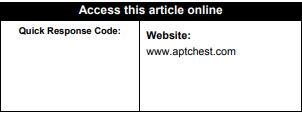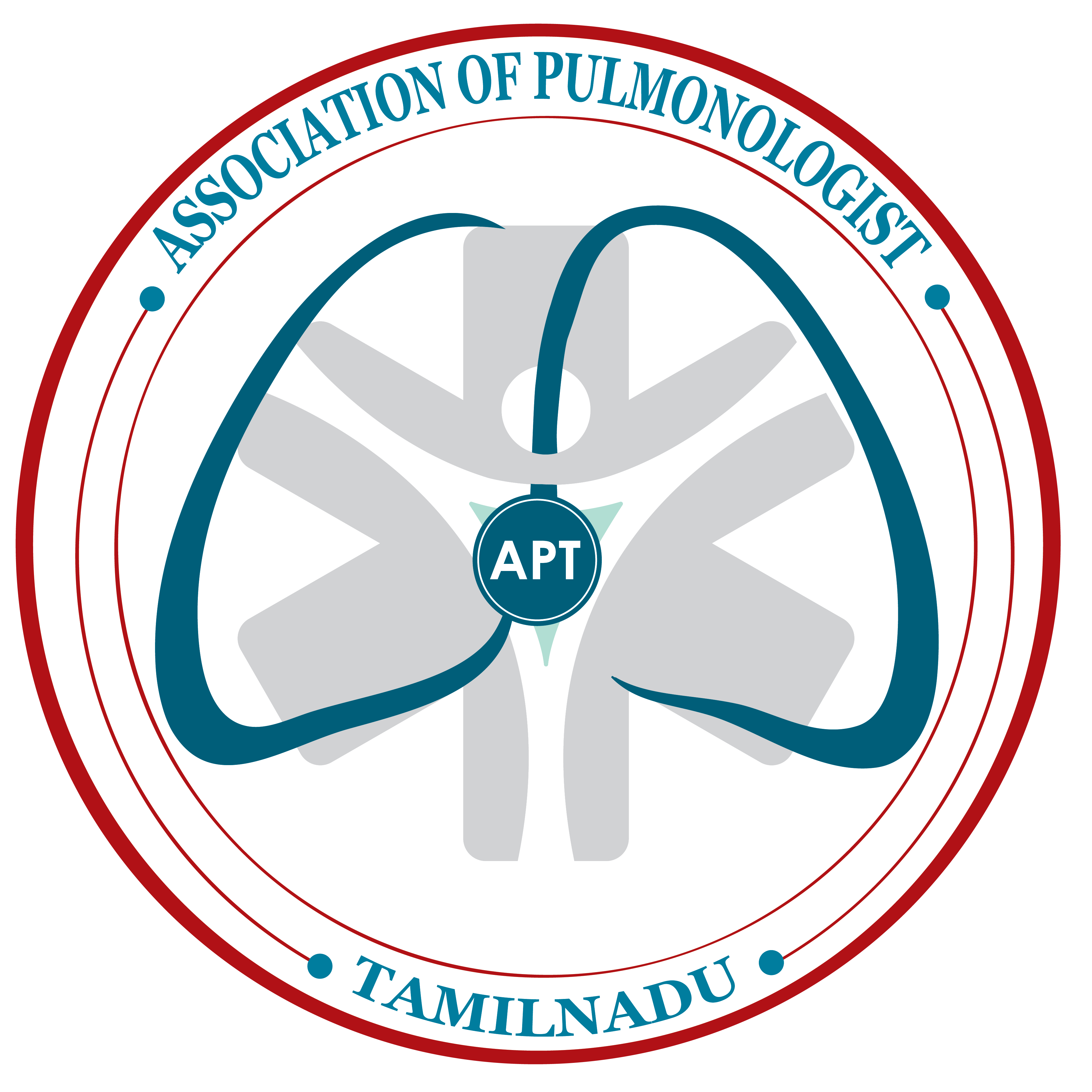A. Manimaran et al.: Role of Rigid Thoracoscopy in Undiagnosed Pleural Effusion: A Prospective Study
Role of Rigid Thoracoscopy in Undiagnosed Pleural Effusion:
A Prospective Study
A. Manimaran1, K.Anbananthan2, A. Nadhiya3, R. Ponnar3
1Senior Resident, Department of Thoracic Medicine, Thanjavur Medical College and Hospital, Thanjavur, Tamil Nadu, India,
2Associate Professor, Department of Thoracic Medicine, Thanjavur Medical College,
3Junior Resident, Department of Thoracic Medicine, Thanjavur Medical College, Tamil Nadu, India
Abstract
Background: Medical thoracoscopy is a minimally invasive, safe, and cost-effective procedure that allows complete visualization of pleural space, enabling diagnostic and therapeutic procedures such as pleural biopsy and talc insufflations. Conservative estimates suggest that 25% of patients seen in general pulmonologist’s practice involve pleura, of these 25% are unable to be attributed to a specific diagnosis, even after thoracentesis and closed pleural biopsy. Aim: The aim of this study was to evaluate the diagnostic yield of rigid thoracoscopy in undiagnosed pleural effusion. Methods: This prospective observational descriptive study was conducted in Thanjavur Medical College Hospital, Tamil Nadu, in the Department of Thoracic Medicine between July 2017 and December 2018. Rigid thoracoscopy equipment was used for investigation. 12 undiagnosed pleural effusion patients after thoracentesis who fulfilled inclusion and exclusion criteria were included in the study. Results: Of the 12 patients, six were male and six were female; seven had right-sided pleural effusion and five had left sided pleural effusion. Investigation reports were inconclusive except for suggesting an exudative effusion. Cytological examinations of pleural fluid were inconclusive in all the patients. After thoracoscopy, tuberculosis was diagnosed in five cases, metastases in three cases, mesothelioma in two cases, and inflammatory pathology in two cases. Conclusion: Thoracoscopy is a safe procedure with high diagnostic yield in undiagnosed exudative pleural effusion (EPE). A simple, minimally invasive low-cost investigation reduces the need for more invasive and much more expensive thoracotomy.Our study proved that rigid thoracoscopy remains the investigation of choice in all undiagnosed EPE for
accurate diagnosis and management.
Keywords: Undiagnosed pleural effusion, Thoracentesis, Diagnostic yield, HPE
Corresponding Author: A. Manimaran, Senior Resident, Department of Thoracic Medicine, Thanjavur Medical College and Hospital,
Thanjavur, Tamil Nadu, India
How to cite this article: A. Manimaran, K.Anbananthan, A. Nadhiya, R. Ponnar, Role of Rigid Thoracoscopy in Undiagnosed Pleural Effusion: A Prospective tudy, JAPT 2019; 2(3):100-104
Introduction
Medical thoracoscopy also known as pleuroscopy is an endoscopic evaluation of the

pleural space. It is a minimally invasive procedure that was first invented by Hans Christian Jacobeus in 1910, who is regarded as “Father of Thoracoscopy.” Jacobeus also published an early report on the use of thoracoscopy to localize and diagnose benign and malignant lesions of the
pleura and pulmonary parenchyma.1 Medical
thoracscopy is usually done for the cases of
undiagnosed exudative pleural effusion (EPE). Pleural fluid aspirate for biochemical, cytological, and microbiological analysis is the initial investigation to diagnose the etiology. Closed pleural biopsy may help in additional cases, but complications such as bleeding and pneumothorax are common. Even after these two procedures, the final diagnosis is not arrived in 25–40% of effusions. There are two fundamental techniques by which thoracoscopy is performed, single puncture technique and double puncture technique.2 For single puncture technique, a 9-mm working channel is used, and for double puncture technique, a 7-mm working channel is used. The single puncture technique is commonly used by the chest physician.2 Thoracic ultrasound before thoracoscopy improves pleural access and predicts fibrous septation.3
Both rigid and semi-rigid thoracoscopes remain valuable in the evaluations and management of pleural disease, but rigid thoracoscope allows excellent visualization and inspection of the thoracic cavity and permits adequate sized biopsy specimens to be obtained.
Study Design and Materials
This is a prospective observational descriptive study conducted in the Department of Thoracic Medicine, Thanjavur Medical College Hospital, a tertiary care teaching hospital in Tamil Nadu. This is the second government medical college in Tamil Nadu, where thoracoscopy is being done. We included 12 patients with undiagnosed EPE. The study was done over 18 months from July 2017 to December 2018.
Undiagnosed pleural effusion was defined as failure to achieve diagnosis by microbiological, biochemical, and cytological analysis of pleural fluid.
Medical thoracoscopy investigation was done on these patients under general anesthesia after verifying that they met the inclusion and exclusion criteria. It was carried out in the Department of Thoracic Medicine, Thanjavur Medical College Hospital.
The inclusion and exclusion criteria are as follows:
Inclusion Criteria
The following criteria were included in the study:
- Undiagnosed EPE as per Light’s criteria.
- Adenosine deaminase (ADA) levels must be
- Cytology was negative for malignancy. No underlying definitive lung pathology causing pleural effusion such as malignancy
Exclusion Criteria
The following criteria were excluded from the study:
- Transudative pleural effusion as per Light’s criteria.
- Pleural fluid ADA >40 IU/lt.
- Pleural fluid cytology positive for malignancy.
- Smear positive for pulmonary tuberculosis. Patient with bleeding diathesis.
Results
During inspection, the most common findings were adhesions, nodules, and sago grain appearance. Of the 12 patients, 6 were male and 6 were female. 7 had right- sided effusion and 5 had left-sided effusion. All the patients were in the age group of 41–65 years. Male-to-female ratio was 1:1,
the youngest was 41 years, and oldest was 65 years [Figures 1 and 2].
Nature and Color of the Pleural Effusion
All the hemorrhagic effusions turned out to be malignant, whereas in straw-colored effusions, five pateints had tuberculosis and two had inflammatory pathology.
Histopathology Results from Pleural Biopsy
Histopathology results confirmed malignancy in five cases, tuberculosis in five cases, while two cases were of inflammatory pathology.
Types of Malignant Lesion
Of five malignancies, three were metastatic adenocarcinomatous deposits and two cases were mesothelioma.


Medical thoracoscopy is a safe and valuable tool for the diagnosis of undiagnosed EPE, particularly for patients with a high probability of malignancy. The main indication in our study was A. Manimaran et al.: Role of Rigid Thoracoscopy in Undiagnosed Pleural Effusion: A Prospective Study 103 Journal of the Association of Pulmonologist of Tamil Nadu JAPT, Volume 2, Issue 3, Sep. – Dec. 2019 recurrent undiagnosed EPE, where etiology remains unexplained after initial and repeated cytological and biochemical analysis of pleural fluid.

Pleural effusion of undetermined etiology has been noted in all age groups. In our study, the age of the patients ranged from 41 to 65 years. In this
study, male and female are equal in number in contrast to many studies where male predominance is seen.4,5 The common thoracoscopic findings were adhesions, nodules, and sago grain appearance. All patients with nodules turned out to be malignant. This correlated with the study done by Helala et
al.5,6
As shown in Table 2 Tuberculosis and malignancy are the two most common HPE findings of pleural biopsy. As shown in Table 3 Only two types of malignant lesions were seen in our patients, metastatic adenocarcinomatous deposits followed by mesothelioma.


Pleural fluid cytology and closed pleural biopsy are two commonly applied procedures for the diagnosis of pleural effusion before thoracoscopy is performed. The diagnostic yield of cytology in malignant pleural effusion varies between 30% and 80%. Closed pleural biopsy increases the yield by about 10% and 40% in malignant and tuberculosis pleural effusions, respectively. However, bleeding and pneumothorax are common complications with closed pleural biopsy. Hence, its usage is minimal nowadays.
However, the diagnostic yield of thoracoscopy is about 83% in both malignant and tuberculous pleural effusions. Hence, thoracoscopy is an excellent diagnostic procedure as it provides direct visualization of the pleural surface which further increases the diagnostic yield.7
Maturu et al. had suggested that medical thoracoscopy is the procedure of choice in the evaluation of undiagnosed EPE, due to its higher success rate and an acceptable safety profile.8 Based on our findings, we concur with them on the same. Rigid thoracoscopy was found to be superior to semirigid thoracoscopy overall.9
Medical thoracoscopy can further progress with a wider adoption of the more interventional procedures and the improvement of equipment. The latter field includes minithoracoscopy.10
Conclusion
Medical thoracoscopy is a safe procedure with high diagnostic yield in undiagnosed EPE. A. Manimaran et al.: Role of Rigid Thoracoscopy in Undiagnosed Pleural Effusion: A Prospective Study 104 Journal of the Association of Pulmonologist of Tamil Nadu JAPT, Volume 2, Issue 3, Sep. – Dec. 2019 Malignant pleural effusion and tuberculosis are the common etiologies of undiagnosed exudative effusion.
Our study supports the notion that medical thoracoscopy remains the investigation of choice in all undiagnosed EPE for accurate diagnosis and management. However, the sample size is minimal, and hence, an elaborate study is needed to further strengthen our findings.
References
- Jacobaeus HC. The practical importance of thoracoscopy in surgery of the chest. Surg Gynaecol Obstet 1992;34:289-96.
- Loddenkemper R. Medical Thoracoscopy In: Light RW, Lee YCG, editors. Textbook of Pleural Diseases, 2nd ed. London, England: Hodder Arnold Publishers; 2008. p. 583-98.
- Medford AR, Agarwal S, Bennett JA, Free CM, Entwisle JJ.Thoracic ultrasound prior to medical thoracoscopy improves pleural access and predicts fibrous septation. Respirology 2010;15:804-8.
- Mootha VK, Agarwal R, Singh N, Aggarwal AN, Gupta D,Jindal SK, et al. Medical thoracoscopy for undiagnosed pleural effusions: Experience from a tertiary care hospital in North India. Indian J Chest Dis Allied Sci 2011;53:21-4.
- Helala LA, EI-Assal GM, Farghally AA, Abd EI Rady MM. Diagnostic yield of medical thoracoscopy in cases of undiagnosed pleural thoracoscopy in cases of undiagnosed pleural effusion in Kobri military hospital. Egy J Chest DiseTuber 2014;63:629-34.
- Prabhu VG, Narasimhan R, The role of pleuroscopy in undiagnosed exudative pleural effusion. Lung India 2012;29:128-30.
- Sodhi R. Sindhwani G. Nadia S, Kumar S, Jethani V, Khanduri S. A three year experience of medical thoracoscopy at a tertiary care center of Himalayan Region.J Cardiothorac Med 2016;4:397-402.
- Maturu VN, Dhooria S, Bal A, Singh N, Aggarwal AN, Gupta D, et al. Role of medical thoracoscopy and closedblind pleural biopsy in undiagnosed exudative pleural effusions: A single-center experienc of 348 patients. J Bronchology Interv Pulmonol 2015;22:121-9.
- Dhooria S, Singh N, Aggarwal AN, Gupta D, Agarwal R. A randomized trial comparing the diagnostic yield of rigid and semirigid thoracoscopy in undiagnosed pleural effusions. Respir Care 2014;59:756-64.
- Tassi G, Marchetti G. Minithoracoscopy: A less invasive approach to thoracoscopy. Chest 2003;124:1975-7.





